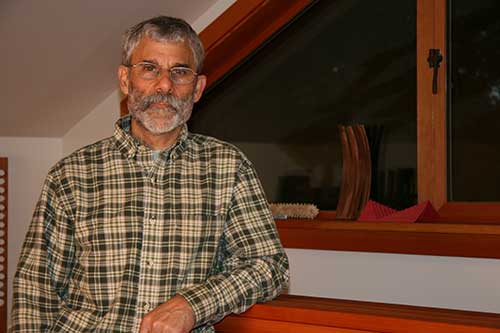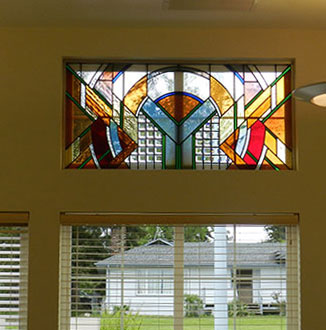By Elizabeth Zach, RCAC staff writer

In this day and age, if you wish to paint, sculpt, sing or dance, chances are you’ll take any job you can get to feed your passion, not to mention put a roof over your head.
But sculptor Paul Vexler, whose delicate wood designs grace university campuses, private homes and offices throughout Washington, has been lucky to be able to earn well as an artist and give back to others. He donates his prized work to affordable housing projects, where residents would not likely see it otherwise.
In 2010, when one of his elegant “helix” installments was about to be returned from its temporary display at Everett Community College, Vexler wondered where he might find it a good home. The meticulous and enigmatic construction of the piece, which suspends from the ceiling, might easily have attracted a buyer willing to pay thousands of dollars for it. The sculptor, after all, was recently recognized as Snohomish County Artist of the Year.
But Vexler had something else in mind.
“With my art, I have several pieces, for one reason or another, that are not going anywhere in terms of my professional work,” says Vexler. “I’ll either give it to my kids or donate it.”
Vexler, a New Jersey native and Everett, Washington resident since 1972, had served on the Housing Hope board of directors since 1987. For many years, he helped guide construction of nearly 60 housing developments north of Seattle. Because of this connection, he knew of another affordable housing project scheduled to open in 2011 in Lincoln Hill Village near Stanwood, which included a community center.
“This is a development that is family-oriented,” says Vexler. “They’re not just some faceless apartment buildings. The community center is where classes can be taught. This is really high-quality, low-income housing. I see it all as quite compatible.” The helix now hangs suspended in the community center lobby.
Vexler was not the only artist who contributed to the project. Jack Archibald crafted two stunning stained glass windows, one for above a doorway, the other for above plain glass windows in the community center.
“I do a lot of glass donations,” Archibald says, noting that he was aware of the Stanwood project because he passes the town to reach his home on Camano Island.

Vexler and Archibald’s goodwill gestures are particularly remarkable these days, as low-income housing is in short supply, and plans to build it often come under fire for attracting crime to neighborhoods. More conservative critics would argue that transitional and affordable housing should not be so comfortable that the inhabitants see no reason to improve their financial standing.
But Vexler sees it differently.
“It would have been ‘too nice’ if Housing Hope had paid $10,000 or $20,000 for the piece,” he said. But, the buildings are well-designed and well-constructed, “because we know they’ll have to be maintained for a long time,” he adds.
And like Vexler, Archibald is quick to refute critics who claim affordable housing shouldn’t afford residents any creature comforts.
“I hear that a lot,” he says. “I hear that we don’t want to spend too much money on these things, or make it like the Taj Mahal. But I don’t buy that argument. To me, it’s philistine. Do we want to just build concrete block houses? We’re more advanced than that.”
Lynda Plummer, Housing Hope’s case management supervisor at Lincoln Hill Village, agrees.
“Having the beautiful double helix and stained glass art in the community building, along with the overall quality of the housing community, helps our families hold their heads high about where they live,” she says. The aesthetics, she notes, highlight “the effort they’re making to grow in self-sufficiency and provide a brighter future for their children.”
During the years, Rural Community Assistance Corporation (RCAC) has worked with Housing Hope to strengthen its self-help housing program, from recruiting families to financial management systems. RCAC also helped Housing Hope to partner with the Tulalip Tribe to offer the Mutual Self-Help Housing program to its members on tribal land.
Housing Hope has completed 53 housing developments since 1987. It manages 347 units in 19 developments, and has helped 257 families build and own their own homes through the U.S. Department of Agriculture Rural Development self-help housing program. As a measure of its success, more than 90 percent of the families who “graduate” from Housing Hope’s transitional housing program go on to obtain long-term stable housing.
**Featured image: Big yellow knot wood design created by Paul Vexler.
All photos were taken by Paul Vexler.
